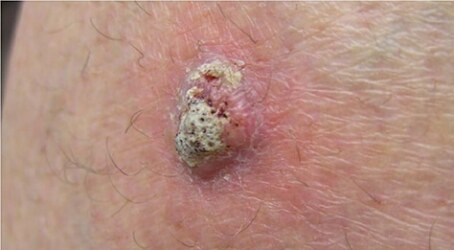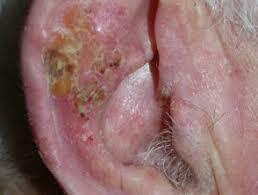Overview
Squamous cell carcinoma (SCC) of the skin
SCC of the skin is a common form of skin cancer that develops in the squamous cells that make up the middle and outer layers of the top layer of skin.
SCC of the skin is usually not life-threatening, though it can be aggressive. Untreated, SCC of the skin can grow large or spread to other parts of your body, causing serious complications.
Most squamous cell carcinomas of the skin result from prolonged exposure to ultraviolet (UV) radiation, either from sunlight or from tanning beds or lamps. Avoiding UV light helps reduce your risk of SCC of the skin and other forms of skin cancer.
Squamous cells are found in many places in your body, and SCC can occur anywhere squamous cells are found. SCC of the skin refers to cancer that forms in the squamous cells found in the skin.
Symptoms
SCC of the skin most often occurs on sun-exposed skin, such as your scalp, the backs of your hands, your ears or your lips. But it can occur anywhere on your body, including inside your mouth, the bottoms of your feet and on your genitals.
Signs and symptoms of SCC of the skin include:
· A firm, red nodule
· A flat sore with a scaly crust
· A new sore or raised area on an old scar or ulcer
· A rough, scaly patch on your lip that may evolve to an open sore
· A red sore or rough patch inside your mouth
· A red, raised patch or wartlike sore on or in the anus or on your genitals
When to see a doctor
Make an appointment with your doctor if you have a sore or scab that doesn't heal in about two months or a flat patch of scaly skin that won't go away.
Causes
Where skin cancer develops
SCC of the skin occurs when the flat, thin squamous cells in the middle and outer layers of your skin develop changes (mutations) in their DNA. A cell's DNA contains the instructions that tell a cell what to do. The mutations tell the squamous cells to grow out of control and to continue living when normal cells would die.
Most of the DNA mutations in skin cells are caused by ultraviolet (UV) radiation found in sunlight and in commercial tanning lamps and tanning beds.
But sun exposure doesn't explain skin cancers that develop on skin not ordinarily exposed to sunlight. This indicates that other factors may contribute to your risk of skin cancer, such as having a condition that weakens your immune system.
Risk factors
Factors that may increase your risk of SCC of the skin include:
· Fair skin. Anyone, regardless of skin color, can get SCC of the skin. However, having less pigment (melanin) in your skin provides less protection from damaging UV radiation.
If you have blond or red hair and light-colored eyes and you freckle or sunburn easily, you're much more likely to develop skin cancer, including squamous cell carcinoma, than is a person with darker skin.
· Excessive sun exposure. Being exposed to UV light from the sun increases your risk of SCC of the skin. Spending lots of time in the sun — particularly if you don't cover your skin with clothing or sunblock — increases your risk of SCC of the skin even more.
· Use of tanning beds. People who use indoor tanning beds have an increased risk of SCC of the skin.
· A history of sunburns. Having had one or more blistering sunburns as a child or teenager increases your risk of developing SCC of the skin as an adult. Sunburns in adulthood also are a risk factor.
· A personal history of precancerous skin lesions. Having a precancerous skin lesion, such as actinic keratosis or Bowen's disease, increases your risk of SCC of the skin.
· A personal history of skin cancer. If you've had SCC of the skin once, you're much more likely to develop it again.
· Weakened immune system. People with weakened immune systems have an increased risk of skin cancer. This includes people who have leukemia or lymphoma and those who take medications that suppress the immune system, such as those who have undergone organ transplants.
· Rare genetic disorder. People with xeroderma pigmentosum, which causes an extreme sensitivity to sunlight, have a greatly increased risk of developing skin cancer.
Complications
Untreated SCC of the skin can destroy nearby healthy tissue, spread to the lymph nodes or other organs, and may be fatal, although this is uncommon.
The risk of aggressive SCC of the skin may be increased in cases where the cancer:
· Is particularly large or deep
· Involves the mucous membranes, such as the lips
· Occurs in a person with a weakened immune system, such as someone who takes anti-rejection medications after an organ transplant or someone who has chronic leukemia
Prevention
Most squamous cell carcinomas of the skin can be prevented. To protect yourself:
· Avoid the sun during the middle of the day. For many people in North America, the sun's rays are strongest between about 10 a.m. and 3 p.m. Schedule outdoor activities for other times of the day, even during winter or when the sky is cloudy.
· Wear sunscreen year-round. Use a broad-spectrum sunscreen with an SPF of at least 30, even on cloudy days. Apply sunscreen generously, and reapply every two hours — or more often if you're swimming or perspiring.
· Wear protective clothing. Cover your skin with dark, tightly woven clothing that covers your arms and legs, and a broad-brimmed hat, which provides more protection than does a baseball cap or visor.
Some companies also sell protective clothing. A dermatologist can recommend an appropriate brand. Don't forget sunglasses. Look for those that block both types of UV radiation — UVA and UVB rays.
· Avoid tanning beds. Tanning beds emit UV rays and can increase your risk of skin cancer.
· Check your skin regularly and report changes to your doctor. Examine your skin often for new skin growths or changes in existing moles, freckles, bumps and birthmarks. With the help of mirrors, check your face, neck, ears and scalp.
Examine your chest and trunk and the tops and undersides of your arms and hands. Examine both the front and back of your legs and your feet, including the soles and the spaces between your toes. Also check your genital area and between your buttocks.
Squamous cell carcinoma (SCC) of the skin



سرطان الخلايا الحرشفية الجلدي
مُلخّص
سرطان الخلايا الحرشفية للجلدافتح مربع الحوار المنبثق
سرطان الخلايا الحرشفية في الجلد هو شكل شائع من سرطان الجلد ينشأ في الخلايا الحرشفية التي تُشكل الطبقات الوسطى والخارجية من الجلد.
عادة ما يكون سرطان الخلايا الحرشفية في الجلد غير مهدِّد للحياة، على الرغم من شدته في بعض الأحيان. إذا لم يُعالَج سرطان الخلايا الحرشفية في الجلد، فقد ينمو حجمه أو ينتشر إلى أجزاء أخرى من الجسم ويؤدِّي إلى حدوث مضاعفات خطيرة.
تنجم معظم حالات سرطان الخلايا الحرشفية في الجلد عن التعرُّض للأشعة فوق البنفسجية لفترات طويلة من الوقت، سواء من الشمس أو أسِرَّة أو مصابيح تسمير البشرة. يساعد تجنب الأشعة فوق البنفسجية على تقليل خطر الإصابة بسرطان الخلايا الحرشفية في الجلد والأشكال الأخرى من سرطان الجلد.
توجد الخلايا الحرشفية في العديد من المناطق بالجسم، ويمكن أن يصيب سرطان الخلايا الحرشفية أيَّ منطقة توجد بها الخلايا الحرشفية. يشير مصطلح سرطان الخلايا الحرشفية في الجلد إلى السرطان الذي يتشكل في الخلايا الحرشفية الموجودة في الجلد.
الأعراض
غالبًا ما يَظهر سرطان الخلايا الحرشفية على الجلد الذي يتعرض للشمس غالبية الوقت؛ مثل فروة الرأس أو ظهر يديكَ أو أذنيكَ أو شفتيكَ. لكن سرطان الخلايا الحرشفية يمكن أن يَظهر في أي مكان على جسمكَ، ويشمل ذلكَ الجزء الداخلي من فمكَ، والجزء السفلي من قدميكَ وأعضائكَ التناسلية.
تشمل علامات وأعراض سرطان الخلايا الحرشفية التي تَظهر على الجلد ما يلي:
· عقيدة حمراء، صلبة
· قرحة مسطحة بقشرة حرشفية
· قرحة جديدة أو منطقة بارزة عن ندبة أو قرحة قديمة
· بقعة خشنة متقشرة على شفتيكَ قد تتطور إلى قرحة مفتوحة
· قرحة حمراء أو بقعة خشنة داخل فمكَ
· بقعة حمراء بارزة أو قرحة تشبه الثآليل على فتحة الشرج أو فيها أو على أعضائكَ التناسلية
متى تزور الطبيب؟
حدِّد موعدًا مع الطبيب في حالة إصابتك بقرحة أو جُلبة لم تلتئم خلال شهرين تقريبًا أو بقعة مسطحة من الجلد المتقشر لا تزول.
الأسباب
موقع تطور سرطان الجلدافتح مربع الحوار المنبثق
ويحدث سرطان الخلايا الحرشفية في الجلد عندما تطور الخلايا الحرشفية الرفيعة المسطحة الموجودة في الطبقة المتوسطة والخارجية من جلدك التغييرات (الطفرات) في الحمض النووي الخاص بها. يحتوي الحمض النووي للخلية على التعليمات التي تخبر الخلية بما يجب القيام به. بينما تخبر الطفرات الخلايا الحرشفية للجلد بالاستمرار في النمو والانقسام خارج السيطرة عندما تموت الخلايا السليمة.
غالبية طفرات الحمض النووي الموجودة في خلايا البشرة تحدث بسبب الأشعة فوق البنفسجية التي توجد في أشعة الشمس، وفي مصابيح التسمير وأسِرَّة تسمير البشرة.
ولكن لا يُفسر التعرُّض لأشعة الشمس سرطانات الجلد التي تُصيب الجلد الذي لا يَتعرض عادةً لأشعة الشمس. ويَدُل هذا على أنَّ هناك عوامل أخرى يُمكن أن تُسهِم في زيادة خطر الإصابة بسرطان الجلد، مثل وجود حالة مرَضية تُضعف الجهاز المناعي.
عوامل الخطر
وتشمل العوامل التي قد تزيد من احتمالية إصابتك بسرطان الخلايا الحرشفية في الجلد:
· بشرة فاتحة. يمكن لأي شخص، بغض النظر عن لون بشرته، أن يصاب بسرطان الخلايا الحرشفية في الجلد. ومع ذلك، فإن وجود صبغة أقل (الميلانين) في جلدك يوفر حماية أقل من الأشعة فوق البنفسجية الضارة.
إذا كان شعرك أشقر أو أحمر وكان لون عينيك فاتحًا وتميل للإصابة بالنمش وحروق الشمس بسهولة، فإن احتمالية إصابتك بسرطان الجلد تزداد عندئذٍ، بما في ذلك سرطان الخلايا الحرشفية، أكثر من الأشخاص أصحاب البشرة الداكنة.
· التعرُّض الزائد للشمس. يزيد التعرض للأشعة فوق البنفسجية للشمس من خطر الإصابة بسرطان الخلايا الحرشفية في الجلد. إن قضاء الكثير من الوقت في الشمس — خاصة إذا كنت لا تغطي بشرتك بالملابس أو لا تدهن كريمًا واقيًا من الشمس — يزيد من خطر الإصابة بسرطان الخلايا الحرشفية في الجلد بشكل أكبر.
· استخدام أسِرَّة تسمير البشرة. الأشخاص الذين يستخدمون أسِرَّة التسمير في الأماكن المغلقة يتزايد خطر إصابتهم بسرطان الخلايا الحرشفية في الجلد.
· تاريخ الإصابة بحروق الشمس. تزداد مخاطر الإصابة بسرطان الخلايا الحرشفية في الجلد بعد البلوغ إذا سبقت الإصابة بحرق أو أكثر من حروق الشمس المصحوبة ببثور أثناء الطفولة أو سنوات المراهقة. حروق الشمس في مرحلة البلوغ هي أيضًا عامل خطر.
· وجود تاريخ شخصي بإصابات محتملة التسرطن في الجلد. وجود آفة جلدية محتملة التسرطن، مثل التَقران السَفعِيّ أو مرض بوين، يزيد من خطر الإصابة بسرطان الخلايا الحرشفية في الجلد.
· وجود تاريخ شخصي للإصابة بسرطان الجلد. إذا تعرضت للإصابة بسرطان الخلايا الحرشفية في الجلد من قبل، فتزداد عندئذٍ احتمالية إصابتك به مرة أخرى.
· ضعف الجهاز المناعي. ترتفع مخاطر الإصابة بسرطان الجلد لدى الأشخاص الذين لديهم ضعفًا في الجهاز المناعي. ويشمل ذلك الأشخاص المصابون بابيضاض الدم أو اللمفومة الذين يتناولون أدوية تثبيط الجهاز المناعي، مثل أولئك الذين خضعوا لعمليات زرع الأعضاء.
· اضطراب وراثي نادر. يتزايد لدى الأشخاص المصابون بجفاف الجلد المُصْطَبِغ، الذي يسبب حساسية شديدة لأشعة الشمس، خطر الإصابة بسرطان الجلد.
المُضاعَفات
سرطان خلايا الجلد الحرشفية غير المعالجة يمكن أن يدمر الأنسجة السليمة القريبة، وينتشر إلى العُقَد اللمفية أو الأعضاء الأخرى، وقد يكون قاتلًا، على الرغم من أن هذا غير شائع.
قد يزداد خطر الإصابة بسرطان الخلايا الجلدية الحرشفية العدوانية في الحالات التي يكون فيها السرطان:
· كبيرًا بشكل خاص أو عميقًا
· منتشرًا بالأغشية المخاطية، مثل الشفاه
· يصيب شخصًا لديه ضعف في جهاز المناعة، مثل شخص يتناول أدوية مضادة لرفض العضو المزروع أو شخصًا مصابًا بابيضاض الدم (لُوكيميا) المزمن
الوقاية
يُمكن وقاية الجلد من معظم سرطان الخلايا الحرشفية. لحماية نفسكَ عليكَ بالتالي:
· تجنَّبِ الشمس خلال فترة منتصف النهار. بالنسبة لأشخاص كثيرين في أمريكا الشمالية، فإن أشعة الشمس هي الأقوى بين الساعة 10 صباحًا والساعة 3 مساءً. قُم بجدولة الأنشطة الخارجية في أوقات أخرى من اليوم، وخلال فصل الشتاء أو عندما تكون السماء غائمة.
· استخدِمْ مستحضرًا واقِيًا من الشمس على مدار السنة. استخدم واقيًا من الشمس واسع النطاق لديه عامل الوقاية الشمسي (SPF) يساوي 30 على الأقل، حتى في الأيام الملبَّدة بالغيوم. ضَعْ واقي الشمس بكمية كبيرة، وكرر وضعه كل ساعتين أو أكثر عند السباحة أو التعرق.
· ارتدِ ملابس واقية. قم بتغطية بشرتكَ بالملابس الداكنة والمنسوجة بإحكام، لتغطية ذراعيكَ وساقيكَ، وارتدِ قبعة عريضة الحواف، مما يوفر حماية أكبر مما تُوفِّره قبعة البيسبول أو قبعة الوجه.
بعض الشركات أيضًا تبيع الملابس الواقية. يُمكن أن يُوصي طبيب الأمراض الجلدية بعلامة تِجارية مناسبة. لا تنسَ ارتداء نظارات الشمس. ابْحَثْ عن تلك التي تحجب كلا النوعين من الأشعة فوق البنفسجية — الأشعة فوق البنفسجية أ والأشعة فوق البنفسجية ب.
· تَجَنَّبْ أجهزة تسمير البشرة. تنبعث من الأنوار المستخدمة في جهاز تسمير البشرة الأشعة فوق البنفسجية، ويُمكن أن تَزيد من خطر الإصابة بسرطان الجلد.
· تفحَّصْ جلدكَ بانتظام، وتحدث مع طبيبكَ بخصوص التغيُّرات التي تَطرأ عليه. افحصْ بشرتكَ للبحث عن حالات النمو الجديدة في البشرة أحيانًا أو تغييرات في الشامات الموجودة، والنمش، والنتوءات، والوحمات. استخدم المرايا، لتَتحقَّق من وجهكَ ورقبتكَ وأذنيكَ وفروة رأسك.
افحصْ صدركَ وجذعكَ وأعلى وأسفل ذراعيكَ ويديك. افحصْ كلًّا من الجزء الأمامي والخلفي من ساقيكَ وقدميكَ، بما في ذلك باطن القدمين والمسافات بين أصابع قدميك. تحقَّقْ أيضًا من منطقة الأعضاء التناسلية وبين الأرداف.
